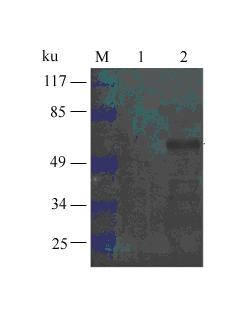ELISA (enzyme-linked immunosorbent assay) detection method for identifying fowl adenovirus group I (FAVI) infection
An avian adenovirus and a detection method technology, which are applied to measurement devices, biological tests, material inspection products, etc., can solve the problems of being unsuitable for the detection of large-scale serum samples, the existence of scattered poison, time-consuming and other problems, and achieve the improvement of prokaryotic expression, The effect of short time and simple operation
- Summary
- Abstract
- Description
- Claims
- Application Information
AI Technical Summary
Problems solved by technology
Method used
Image
Examples
Embodiment 1
[0043] 1. Cloning of 100K genes
[0044] 1. Extraction of group I poultry adenovirus DNA
[0045] Use the Tiangen Biochemical Technology Blood / Cell / Tissue Genomic DNA Extraction Kit to extract DNA directly from the allantoic fluid of chicken embryo lethal orphan virus (CELOV) seed poison passage purchased from the China Veterinary Drug Administration, and operate according to the kit Manual, the specific steps are as follows:
[0046] (1) Take 180uL of allantoic fluid, add 20uLGA, 20uL proteinase K, mix well, and digest at 56°C for 4h.
[0047] (2) Add 200uL buffer GB, mix thoroughly by inversion, place at 70°C for 10 minutes, the solution should become clear, and centrifuge briefly to remove water droplets on the inner wall of the tube cap.
[0048] (3) Add 200uL of absolute ethanol, shake and mix well for 15 seconds, at this time flocculent sediment may appear, centrifuge briefly to remove water droplets on the inner wall of the tube cap.
[0049] (4) Add the solution and...
Embodiment 2
[0151] Prepare 100K recombinant protein according to steps one to five in Example 1
[0152] 6. Establishment of 100K indirect ELISA detection method
[0153] The purified 100K recombinant protein was used as an antigen to establish an indirect ELISA method. The specific steps are as follows:
[0154] (1) Coating: Dilute the 100K protein of group I poultry adenovirus expressed by the prokaryotic to the working concentration of 1ug / mL with the coating solution, add to a 96-well ELISA plate, 100uL per well, incubate at 37°C for 1h, and place at 4°C 12h, wash the plate 3 times with PBST, and pat dry;
[0155] (2) Sealing: add 200uL 5% skimmed milk to each well, seal at 37°C for 1 hour, wash the plate 3 times with PBST, and pat dry;
[0156] (3) Binding with serum: add the serum sample to be tested, 100uL / well, set positive and negative standard samples as controls, incubate at 37°C for 1h, wash the plate 3 times with PBST, and pat dry;
[0157] (4) Binding to enzyme-labeled se...
Embodiment 3
[0164] Prepare 100K recombinant protein according to steps one to five in Example 1
[0165] 6. Establishment of 100K indirect ELISA detection method
[0166] The purified 100K recombinant protein was used as an antigen to establish an indirect ELISA method. The specific steps are as follows:
[0167] (1) Coating: Dilute the 100K protein of group I poultry adenovirus expressed by prokaryotic to the working concentration of 10ug / mL with the coating solution, add 100uL per well to a 96-well ELISA plate, incubate at 37°C for 1h, and place at 4°C 15h, wash the plate 3 times with PBST, and pat dry;
[0168] (2) Sealing: add 200uL 5% skimmed milk to each well, seal at 37°C for 1 hour, wash the plate 3 times with PBST, and pat dry;
[0169] (3) Binding with serum: add the serum sample to be tested, 100uL / well, set positive and negative standard samples as controls, incubate at 37°C for 1h, wash the plate 3 times with PBST, and pat dry;
[0170] (4) Binding to the enzyme-labeled se...
PUM
 Login to View More
Login to View More Abstract
Description
Claims
Application Information
 Login to View More
Login to View More - R&D
- Intellectual Property
- Life Sciences
- Materials
- Tech Scout
- Unparalleled Data Quality
- Higher Quality Content
- 60% Fewer Hallucinations
Browse by: Latest US Patents, China's latest patents, Technical Efficacy Thesaurus, Application Domain, Technology Topic, Popular Technical Reports.
© 2025 PatSnap. All rights reserved.Legal|Privacy policy|Modern Slavery Act Transparency Statement|Sitemap|About US| Contact US: help@patsnap.com



